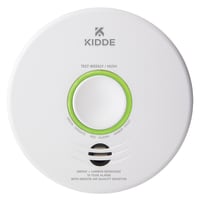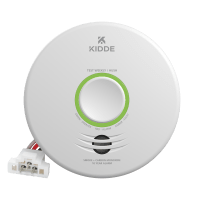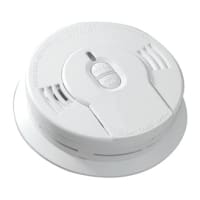Several things could be causing your alarm(s) to alarm briefly or chirp randomly without a regular pattern. Here are some reasons why this could be happening, and how to stop your smoke alarm from beeping.
Loose, or Improperly Installed Battery
Refer to the following checklist and determine if one of these conditions might be the cause of your problem:
-
Verify that a battery of the recommended type is securely installed.
-
Make sure to use a battery with a use-by date no later than four to five years in the future.
-
Check that the battery is snapped in completely so it cannot be shaken loose.
-
It is possible that battery connections may not be making good contact with the battery. Disconnecting and re-connecting the battery once or twice will likely fix this.
-
-
On units with a front-load battery, be sure that the battery compartment door is closed completely as well.
-
Loose white neutral wire can cause an echoing chirp from one unit to the next.
-
Environmental Conditions
Refer to the following environmental conditions for possible solutions to an alarm’s random chirping:
-
Humidity, steam and condensation
-
Excess air flow: Check to see if there's a cooling/heating register, a ceiling fan, or an open window within three feet of the alarm. If there is, move the alarm away from the source of the increased airflow. Check your user's manual for the correct placement for the alarm.
-
Temperature - Check the temperature of the room. Smoke alarms operate at 40 degrees to 95 degrees Fahrenheit. Carbon monoxide alarms operate at 40 degrees to 100 degrees Fahrenheit.
-
Extreme temperature changes
-
High ambient humidity
-
Unit being installed in an insulated electrical box mounted on a ceiling beneath an attic
Resetting the Alarm
Some smoke alarms have a processor that retains certain error conditions, such as a weak battery. The error condition should reset when the battery is replaced, but sometimes it doesn't and must be manually reset to clear the error.
To reset an AC unit with a battery backup, perform the following steps:
-
Turn off the power to the smoke alarm at the circuit breaker.
-
Remove the smoke alarm from the mounting bracket and disconnect the power.
-
Remove the battery.
-
Press and hold the test button for at least 15 seconds. The unit may chirp or alarm for a few seconds before going silent.
-
Reconnect the power and reinstall the battery. The unit will chirp once when the power is restored and should not chirp afterwards.
To reset a DC only unit, perform the following steps:
-
Remove the battery.
-
Press and hold the test button for at least 15 seconds. The unit may chirp or alarm for a few seconds before going silent.
-
Reinstall the battery. The unit will chirp when the battery is first connected but should not chirp afterwards.
Electrical Condition
If the AC power to the unit is interrupted, the unit will chirp when the power is restored. This could be caused by power surges. Refer to the following for specific causes related to an electrical condition:
-
If the chirping seems to occur at about the same time in the evening or morning, it could be due to a surge created when the power company switches electrical grids to meet demand.
-
Check to see if the chirp (or chirping) occurs when something else in the house is turned on, such as an exhaust or attic fan, a heater, etc. If the smoke alarm is connected to a circuit with such a device, the alarm may chirp when the other device is switched on.
If this is the case and the device is plugged into a wall outlet, move it to another outlet on a different circuit. If it is a hardwired device, have an electrician investigate it.
These conditions can be minimized by installing your alarms on a dedicated circuit in compliance with NFPA requirements.
Alarm Needs to be Replaced
If none of these conditions exist and the suggestions don't alleviate the symptom, the alarm should be replaced, since age may be a factor. Smoke and heat alarms should be replaced every 10 years, and carbon monoxide and combination alarms should be replaced every 7 years. Most of our alarms have a 5 year warranty from date of purchase (check your user manual). A date code is stamped on the label attached to the back of the unit.
If the unit is out of warranty, purchase a replacement product immediately.
If the unit is within warranty, please call Product Support at 1-800-880-6788. For more information about your specific alarm, refer to your user’s manual.





